Menu Planning Report: Factors, Design, and Implementation
VerifiedAdded on 2020/02/03
|17
|5200
|40
Report
AI Summary
This report provides a comprehensive overview of menu planning within the hospitality sector. It begins with an introduction to the industry's growth and the importance of effective menu planning for restaurants and food service establishments. The report delves into the principles of recipe development, different types of menus (Table d'hote, A' la Carte, Carte du Jour), and various food production systems. It explores the factors that influence menu planning decisions, including competition, location, current trends, food availability, health considerations, and costs. The report also examines the factors influencing service methods, such as dish appearance, restaurant ambiance, human resource availability, and equipment availability. Furthermore, it outlines the stages of menu development planning, including idea generation, screening, development, business analysis, market testing, technical implementation, and commercialization. The report discusses the influence of the development process on profitability, value analysis, pricing, and forecasting. The report concludes with a discussion on menu design, development of food service environments, and the creation of new food concepts.

MENU
PLANNING
1
PLANNING
1
Paraphrase This Document
Need a fresh take? Get an instant paraphrase of this document with our AI Paraphraser
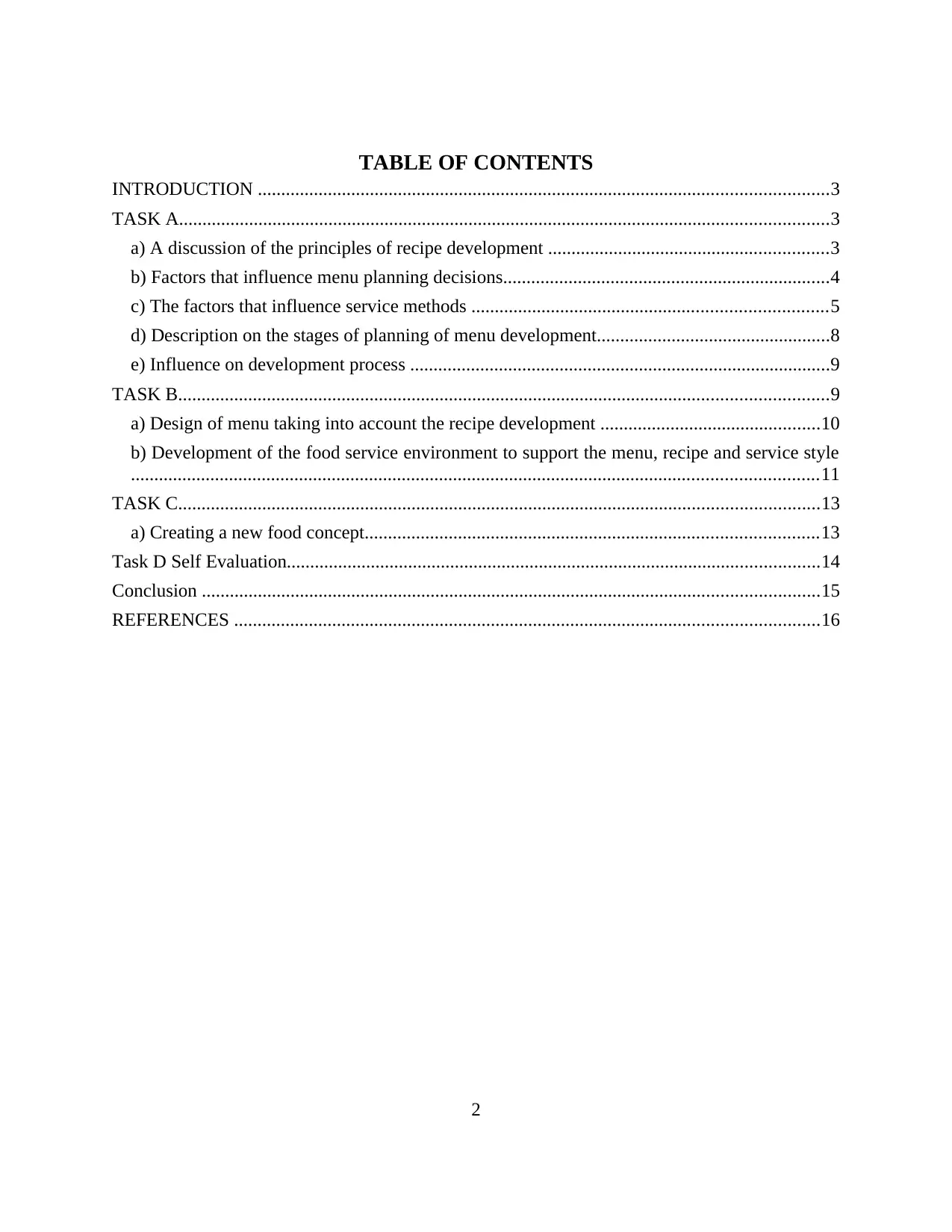
TABLE OF CONTENTS
INTRODUCTION ..........................................................................................................................3
TASK A...........................................................................................................................................3
a) A discussion of the principles of recipe development ............................................................3
b) Factors that influence menu planning decisions......................................................................4
c) The factors that influence service methods ............................................................................5
d) Description on the stages of planning of menu development..................................................8
e) Influence on development process ..........................................................................................9
TASK B...........................................................................................................................................9
a) Design of menu taking into account the recipe development ...............................................10
b) Development of the food service environment to support the menu, recipe and service style
...................................................................................................................................................11
TASK C.........................................................................................................................................13
a) Creating a new food concept.................................................................................................13
Task D Self Evaluation..................................................................................................................14
Conclusion ....................................................................................................................................15
REFERENCES .............................................................................................................................16
2
INTRODUCTION ..........................................................................................................................3
TASK A...........................................................................................................................................3
a) A discussion of the principles of recipe development ............................................................3
b) Factors that influence menu planning decisions......................................................................4
c) The factors that influence service methods ............................................................................5
d) Description on the stages of planning of menu development..................................................8
e) Influence on development process ..........................................................................................9
TASK B...........................................................................................................................................9
a) Design of menu taking into account the recipe development ...............................................10
b) Development of the food service environment to support the menu, recipe and service style
...................................................................................................................................................11
TASK C.........................................................................................................................................13
a) Creating a new food concept.................................................................................................13
Task D Self Evaluation..................................................................................................................14
Conclusion ....................................................................................................................................15
REFERENCES .............................................................................................................................16
2
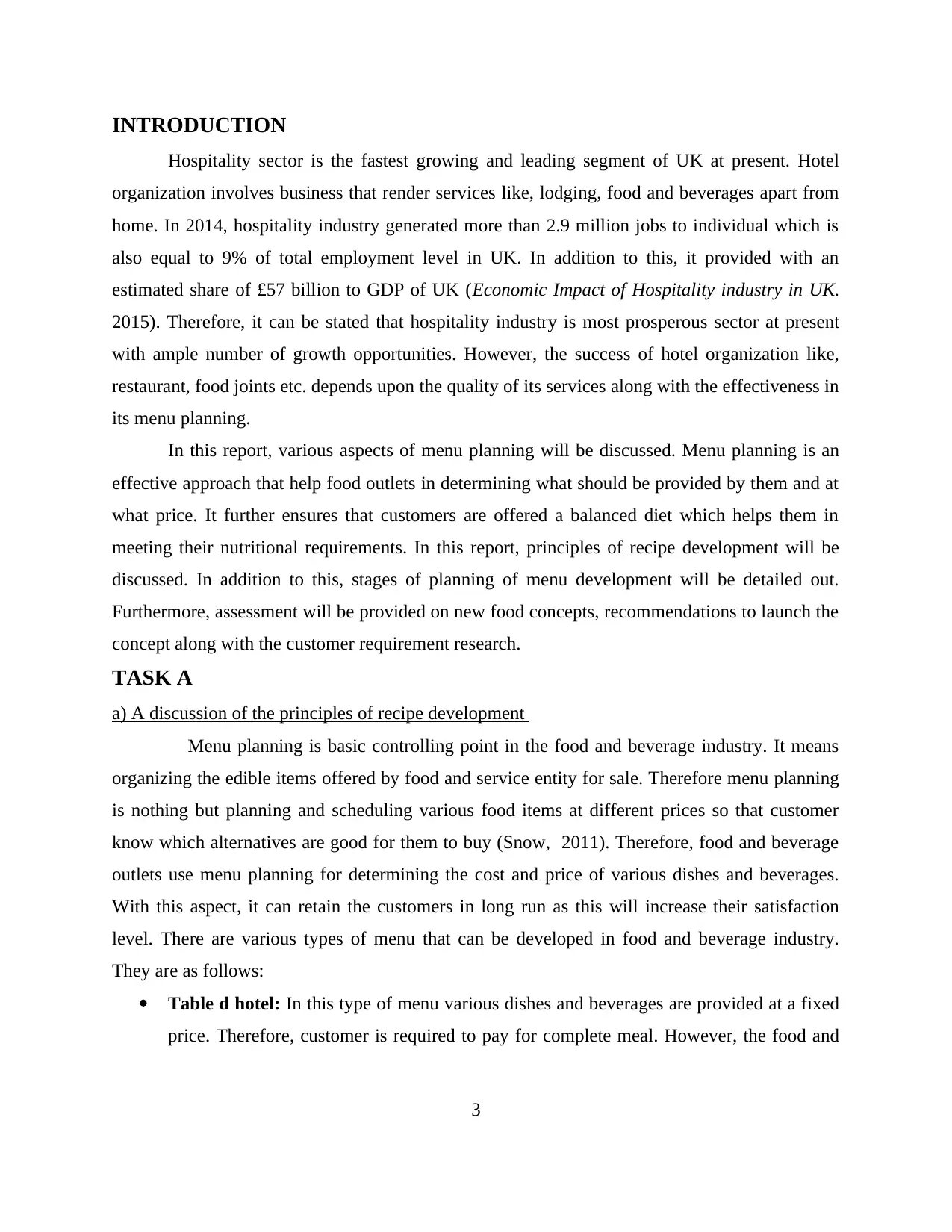
INTRODUCTION
Hospitality sector is the fastest growing and leading segment of UK at present. Hotel
organization involves business that render services like, lodging, food and beverages apart from
home. In 2014, hospitality industry generated more than 2.9 million jobs to individual which is
also equal to 9% of total employment level in UK. In addition to this, it provided with an
estimated share of £57 billion to GDP of UK (Economic Impact of Hospitality industry in UK.
2015). Therefore, it can be stated that hospitality industry is most prosperous sector at present
with ample number of growth opportunities. However, the success of hotel organization like,
restaurant, food joints etc. depends upon the quality of its services along with the effectiveness in
its menu planning.
In this report, various aspects of menu planning will be discussed. Menu planning is an
effective approach that help food outlets in determining what should be provided by them and at
what price. It further ensures that customers are offered a balanced diet which helps them in
meeting their nutritional requirements. In this report, principles of recipe development will be
discussed. In addition to this, stages of planning of menu development will be detailed out.
Furthermore, assessment will be provided on new food concepts, recommendations to launch the
concept along with the customer requirement research.
TASK A
a) A discussion of the principles of recipe development
Menu planning is basic controlling point in the food and beverage industry. It means
organizing the edible items offered by food and service entity for sale. Therefore menu planning
is nothing but planning and scheduling various food items at different prices so that customer
know which alternatives are good for them to buy (Snow, 2011). Therefore, food and beverage
outlets use menu planning for determining the cost and price of various dishes and beverages.
With this aspect, it can retain the customers in long run as this will increase their satisfaction
level. There are various types of menu that can be developed in food and beverage industry.
They are as follows:
Table d hotel: In this type of menu various dishes and beverages are provided at a fixed
price. Therefore, customer is required to pay for complete meal. However, the food and
3
Hospitality sector is the fastest growing and leading segment of UK at present. Hotel
organization involves business that render services like, lodging, food and beverages apart from
home. In 2014, hospitality industry generated more than 2.9 million jobs to individual which is
also equal to 9% of total employment level in UK. In addition to this, it provided with an
estimated share of £57 billion to GDP of UK (Economic Impact of Hospitality industry in UK.
2015). Therefore, it can be stated that hospitality industry is most prosperous sector at present
with ample number of growth opportunities. However, the success of hotel organization like,
restaurant, food joints etc. depends upon the quality of its services along with the effectiveness in
its menu planning.
In this report, various aspects of menu planning will be discussed. Menu planning is an
effective approach that help food outlets in determining what should be provided by them and at
what price. It further ensures that customers are offered a balanced diet which helps them in
meeting their nutritional requirements. In this report, principles of recipe development will be
discussed. In addition to this, stages of planning of menu development will be detailed out.
Furthermore, assessment will be provided on new food concepts, recommendations to launch the
concept along with the customer requirement research.
TASK A
a) A discussion of the principles of recipe development
Menu planning is basic controlling point in the food and beverage industry. It means
organizing the edible items offered by food and service entity for sale. Therefore menu planning
is nothing but planning and scheduling various food items at different prices so that customer
know which alternatives are good for them to buy (Snow, 2011). Therefore, food and beverage
outlets use menu planning for determining the cost and price of various dishes and beverages.
With this aspect, it can retain the customers in long run as this will increase their satisfaction
level. There are various types of menu that can be developed in food and beverage industry.
They are as follows:
Table d hotel: In this type of menu various dishes and beverages are provided at a fixed
price. Therefore, customer is required to pay for complete meal. However, the food and
3
⊘ This is a preview!⊘
Do you want full access?
Subscribe today to unlock all pages.

Trusted by 1+ million students worldwide
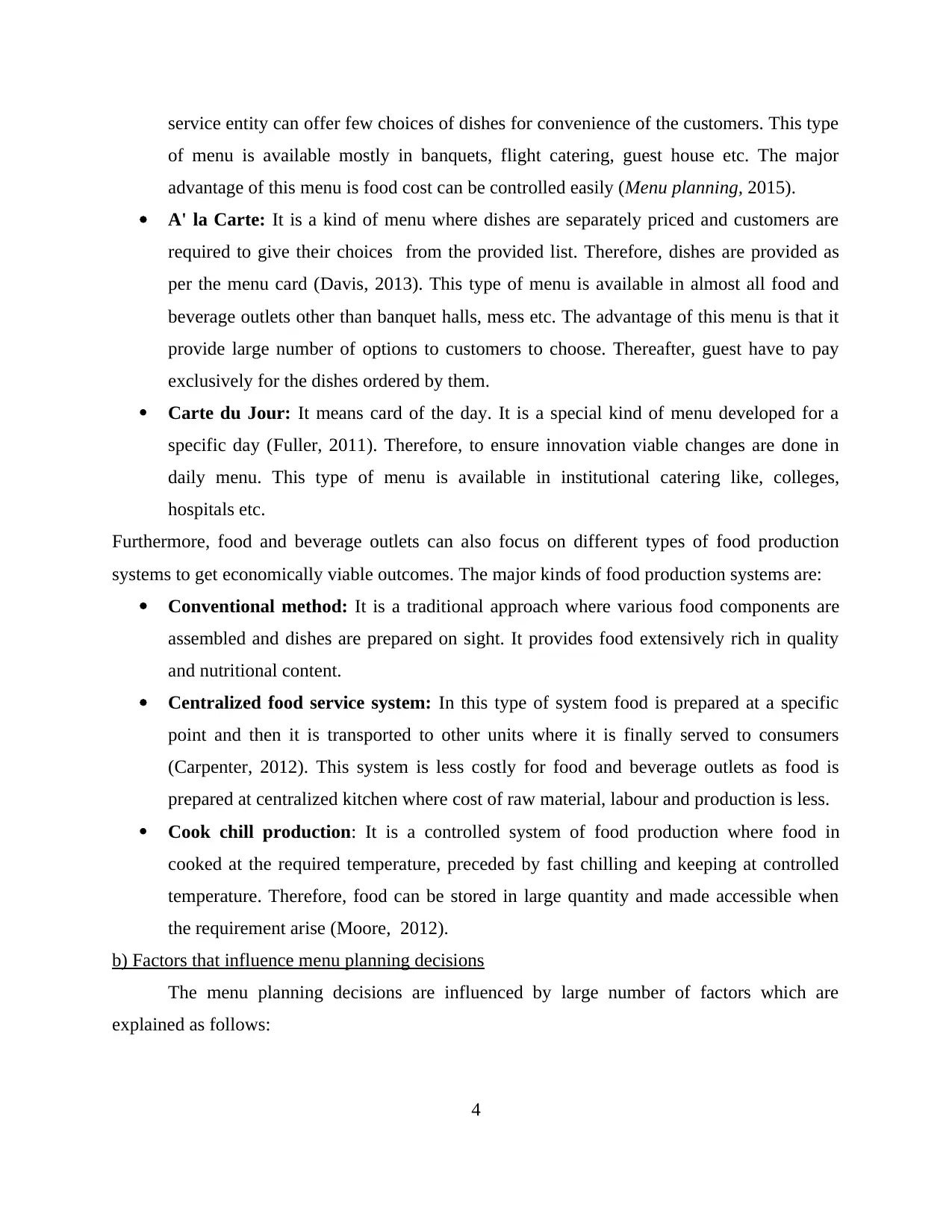
service entity can offer few choices of dishes for convenience of the customers. This type
of menu is available mostly in banquets, flight catering, guest house etc. The major
advantage of this menu is food cost can be controlled easily (Menu planning, 2015).
A' la Carte: It is a kind of menu where dishes are separately priced and customers are
required to give their choices from the provided list. Therefore, dishes are provided as
per the menu card (Davis, 2013). This type of menu is available in almost all food and
beverage outlets other than banquet halls, mess etc. The advantage of this menu is that it
provide large number of options to customers to choose. Thereafter, guest have to pay
exclusively for the dishes ordered by them.
Carte du Jour: It means card of the day. It is a special kind of menu developed for a
specific day (Fuller, 2011). Therefore, to ensure innovation viable changes are done in
daily menu. This type of menu is available in institutional catering like, colleges,
hospitals etc.
Furthermore, food and beverage outlets can also focus on different types of food production
systems to get economically viable outcomes. The major kinds of food production systems are:
Conventional method: It is a traditional approach where various food components are
assembled and dishes are prepared on sight. It provides food extensively rich in quality
and nutritional content.
Centralized food service system: In this type of system food is prepared at a specific
point and then it is transported to other units where it is finally served to consumers
(Carpenter, 2012). This system is less costly for food and beverage outlets as food is
prepared at centralized kitchen where cost of raw material, labour and production is less.
Cook chill production: It is a controlled system of food production where food in
cooked at the required temperature, preceded by fast chilling and keeping at controlled
temperature. Therefore, food can be stored in large quantity and made accessible when
the requirement arise (Moore, 2012).
b) Factors that influence menu planning decisions
The menu planning decisions are influenced by large number of factors which are
explained as follows:
4
of menu is available mostly in banquets, flight catering, guest house etc. The major
advantage of this menu is food cost can be controlled easily (Menu planning, 2015).
A' la Carte: It is a kind of menu where dishes are separately priced and customers are
required to give their choices from the provided list. Therefore, dishes are provided as
per the menu card (Davis, 2013). This type of menu is available in almost all food and
beverage outlets other than banquet halls, mess etc. The advantage of this menu is that it
provide large number of options to customers to choose. Thereafter, guest have to pay
exclusively for the dishes ordered by them.
Carte du Jour: It means card of the day. It is a special kind of menu developed for a
specific day (Fuller, 2011). Therefore, to ensure innovation viable changes are done in
daily menu. This type of menu is available in institutional catering like, colleges,
hospitals etc.
Furthermore, food and beverage outlets can also focus on different types of food production
systems to get economically viable outcomes. The major kinds of food production systems are:
Conventional method: It is a traditional approach where various food components are
assembled and dishes are prepared on sight. It provides food extensively rich in quality
and nutritional content.
Centralized food service system: In this type of system food is prepared at a specific
point and then it is transported to other units where it is finally served to consumers
(Carpenter, 2012). This system is less costly for food and beverage outlets as food is
prepared at centralized kitchen where cost of raw material, labour and production is less.
Cook chill production: It is a controlled system of food production where food in
cooked at the required temperature, preceded by fast chilling and keeping at controlled
temperature. Therefore, food can be stored in large quantity and made accessible when
the requirement arise (Moore, 2012).
b) Factors that influence menu planning decisions
The menu planning decisions are influenced by large number of factors which are
explained as follows:
4
Paraphrase This Document
Need a fresh take? Get an instant paraphrase of this document with our AI Paraphraser
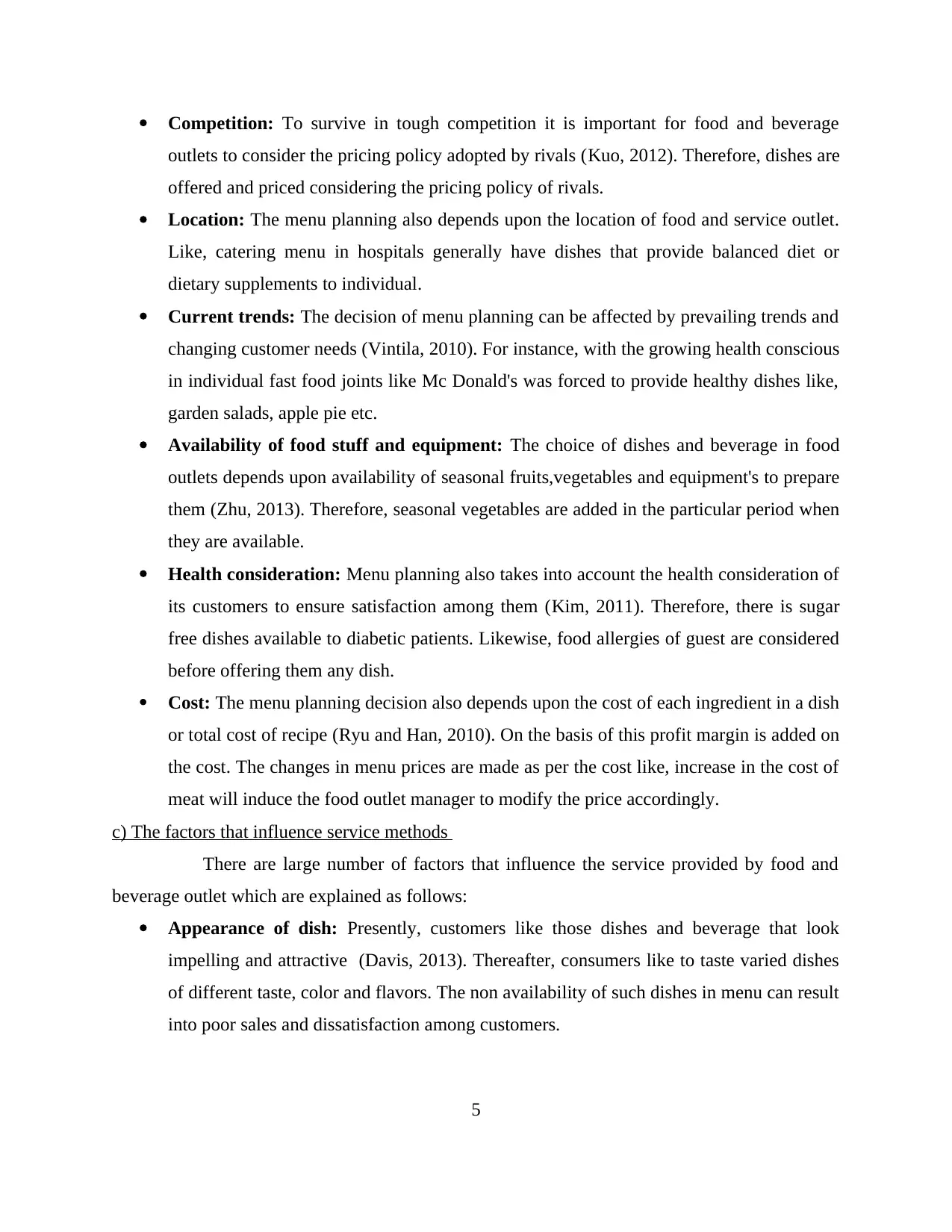
Competition: To survive in tough competition it is important for food and beverage
outlets to consider the pricing policy adopted by rivals (Kuo, 2012). Therefore, dishes are
offered and priced considering the pricing policy of rivals.
Location: The menu planning also depends upon the location of food and service outlet.
Like, catering menu in hospitals generally have dishes that provide balanced diet or
dietary supplements to individual.
Current trends: The decision of menu planning can be affected by prevailing trends and
changing customer needs (Vintila, 2010). For instance, with the growing health conscious
in individual fast food joints like Mc Donald's was forced to provide healthy dishes like,
garden salads, apple pie etc.
Availability of food stuff and equipment: The choice of dishes and beverage in food
outlets depends upon availability of seasonal fruits,vegetables and equipment's to prepare
them (Zhu, 2013). Therefore, seasonal vegetables are added in the particular period when
they are available.
Health consideration: Menu planning also takes into account the health consideration of
its customers to ensure satisfaction among them (Kim, 2011). Therefore, there is sugar
free dishes available to diabetic patients. Likewise, food allergies of guest are considered
before offering them any dish.
Cost: The menu planning decision also depends upon the cost of each ingredient in a dish
or total cost of recipe (Ryu and Han, 2010). On the basis of this profit margin is added on
the cost. The changes in menu prices are made as per the cost like, increase in the cost of
meat will induce the food outlet manager to modify the price accordingly.
c) The factors that influence service methods
There are large number of factors that influence the service provided by food and
beverage outlet which are explained as follows:
Appearance of dish: Presently, customers like those dishes and beverage that look
impelling and attractive (Davis, 2013). Thereafter, consumers like to taste varied dishes
of different taste, color and flavors. The non availability of such dishes in menu can result
into poor sales and dissatisfaction among customers.
5
outlets to consider the pricing policy adopted by rivals (Kuo, 2012). Therefore, dishes are
offered and priced considering the pricing policy of rivals.
Location: The menu planning also depends upon the location of food and service outlet.
Like, catering menu in hospitals generally have dishes that provide balanced diet or
dietary supplements to individual.
Current trends: The decision of menu planning can be affected by prevailing trends and
changing customer needs (Vintila, 2010). For instance, with the growing health conscious
in individual fast food joints like Mc Donald's was forced to provide healthy dishes like,
garden salads, apple pie etc.
Availability of food stuff and equipment: The choice of dishes and beverage in food
outlets depends upon availability of seasonal fruits,vegetables and equipment's to prepare
them (Zhu, 2013). Therefore, seasonal vegetables are added in the particular period when
they are available.
Health consideration: Menu planning also takes into account the health consideration of
its customers to ensure satisfaction among them (Kim, 2011). Therefore, there is sugar
free dishes available to diabetic patients. Likewise, food allergies of guest are considered
before offering them any dish.
Cost: The menu planning decision also depends upon the cost of each ingredient in a dish
or total cost of recipe (Ryu and Han, 2010). On the basis of this profit margin is added on
the cost. The changes in menu prices are made as per the cost like, increase in the cost of
meat will induce the food outlet manager to modify the price accordingly.
c) The factors that influence service methods
There are large number of factors that influence the service provided by food and
beverage outlet which are explained as follows:
Appearance of dish: Presently, customers like those dishes and beverage that look
impelling and attractive (Davis, 2013). Thereafter, consumers like to taste varied dishes
of different taste, color and flavors. The non availability of such dishes in menu can result
into poor sales and dissatisfaction among customers.
5
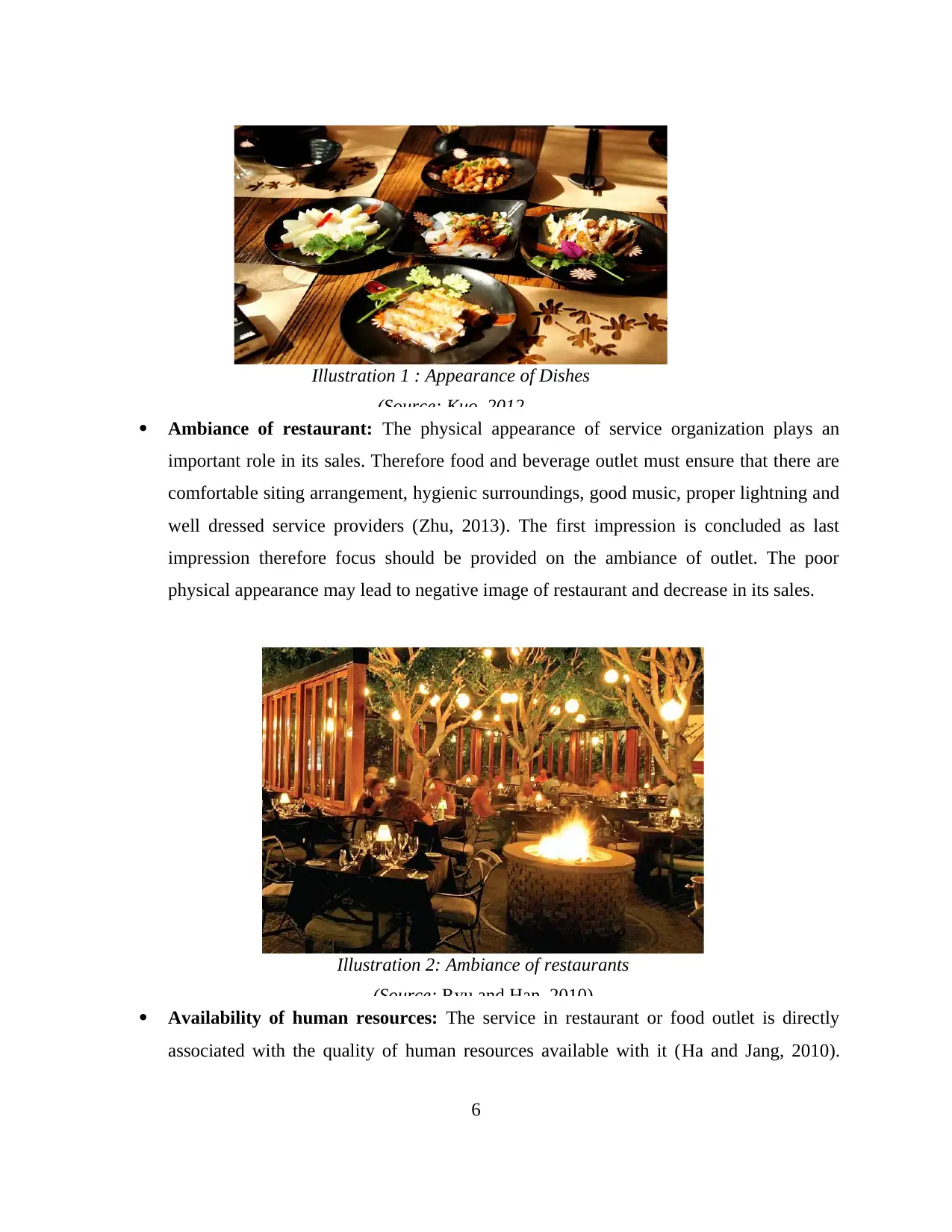
Ambiance of restaurant: The physical appearance of service organization plays an
important role in its sales. Therefore food and beverage outlet must ensure that there are
comfortable siting arrangement, hygienic surroundings, good music, proper lightning and
well dressed service providers (Zhu, 2013). The first impression is concluded as last
impression therefore focus should be provided on the ambiance of outlet. The poor
physical appearance may lead to negative image of restaurant and decrease in its sales.
Availability of human resources: The service in restaurant or food outlet is directly
associated with the quality of human resources available with it (Ha and Jang, 2010).
6
Illustration 1 : Appearance of Dishes
(Source: Kuo, 2012
Illustration 2: Ambiance of restaurants
(Source: Ryu and Han, 2010)
important role in its sales. Therefore food and beverage outlet must ensure that there are
comfortable siting arrangement, hygienic surroundings, good music, proper lightning and
well dressed service providers (Zhu, 2013). The first impression is concluded as last
impression therefore focus should be provided on the ambiance of outlet. The poor
physical appearance may lead to negative image of restaurant and decrease in its sales.
Availability of human resources: The service in restaurant or food outlet is directly
associated with the quality of human resources available with it (Ha and Jang, 2010).
6
Illustration 1 : Appearance of Dishes
(Source: Kuo, 2012
Illustration 2: Ambiance of restaurants
(Source: Ryu and Han, 2010)
⊘ This is a preview!⊘
Do you want full access?
Subscribe today to unlock all pages.

Trusted by 1+ million students worldwide
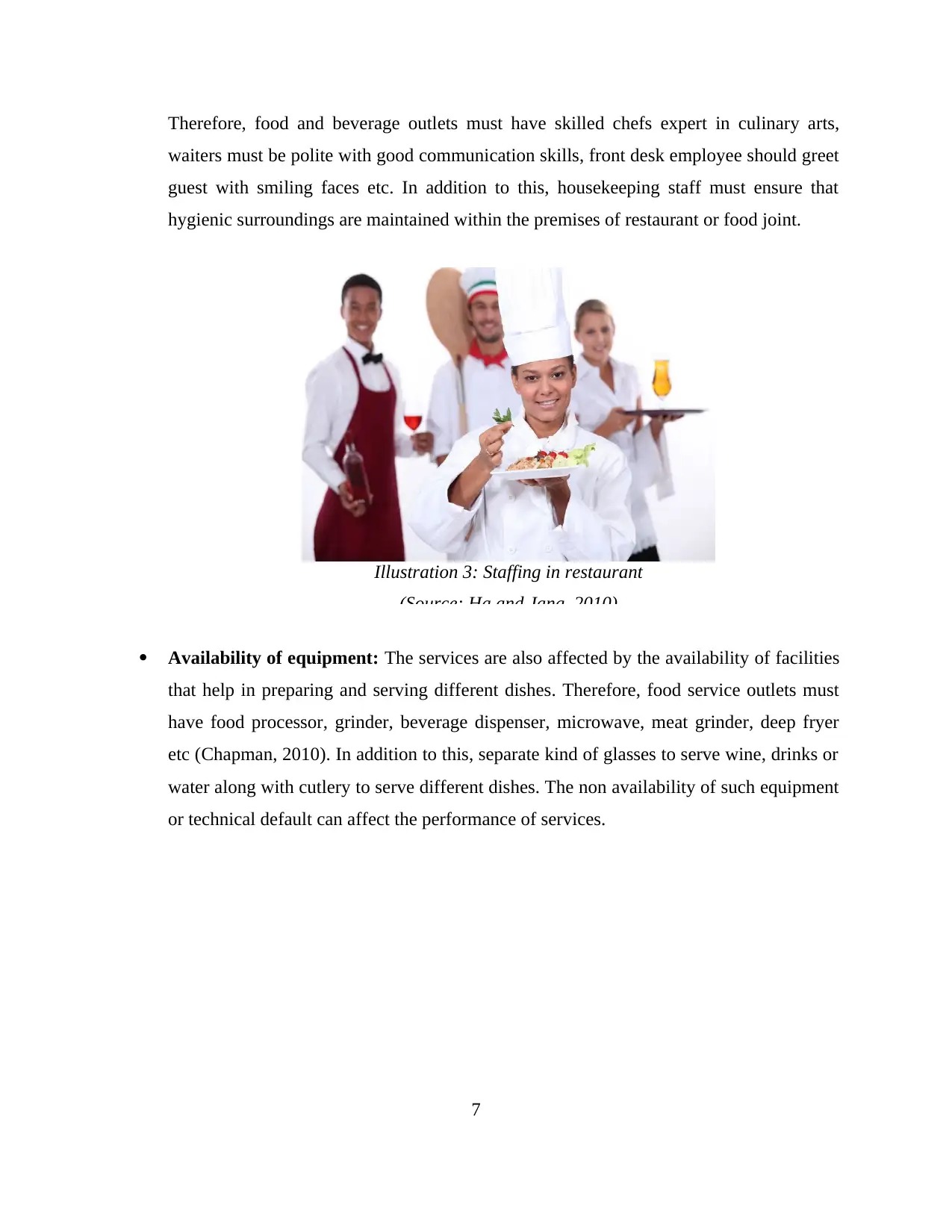
Therefore, food and beverage outlets must have skilled chefs expert in culinary arts,
waiters must be polite with good communication skills, front desk employee should greet
guest with smiling faces etc. In addition to this, housekeeping staff must ensure that
hygienic surroundings are maintained within the premises of restaurant or food joint.
Availability of equipment: The services are also affected by the availability of facilities
that help in preparing and serving different dishes. Therefore, food service outlets must
have food processor, grinder, beverage dispenser, microwave, meat grinder, deep fryer
etc (Chapman, 2010). In addition to this, separate kind of glasses to serve wine, drinks or
water along with cutlery to serve different dishes. The non availability of such equipment
or technical default can affect the performance of services.
7
Illustration 3: Staffing in restaurant
(Source: Ha and Jang, 2010)
waiters must be polite with good communication skills, front desk employee should greet
guest with smiling faces etc. In addition to this, housekeeping staff must ensure that
hygienic surroundings are maintained within the premises of restaurant or food joint.
Availability of equipment: The services are also affected by the availability of facilities
that help in preparing and serving different dishes. Therefore, food service outlets must
have food processor, grinder, beverage dispenser, microwave, meat grinder, deep fryer
etc (Chapman, 2010). In addition to this, separate kind of glasses to serve wine, drinks or
water along with cutlery to serve different dishes. The non availability of such equipment
or technical default can affect the performance of services.
7
Illustration 3: Staffing in restaurant
(Source: Ha and Jang, 2010)
Paraphrase This Document
Need a fresh take? Get an instant paraphrase of this document with our AI Paraphraser
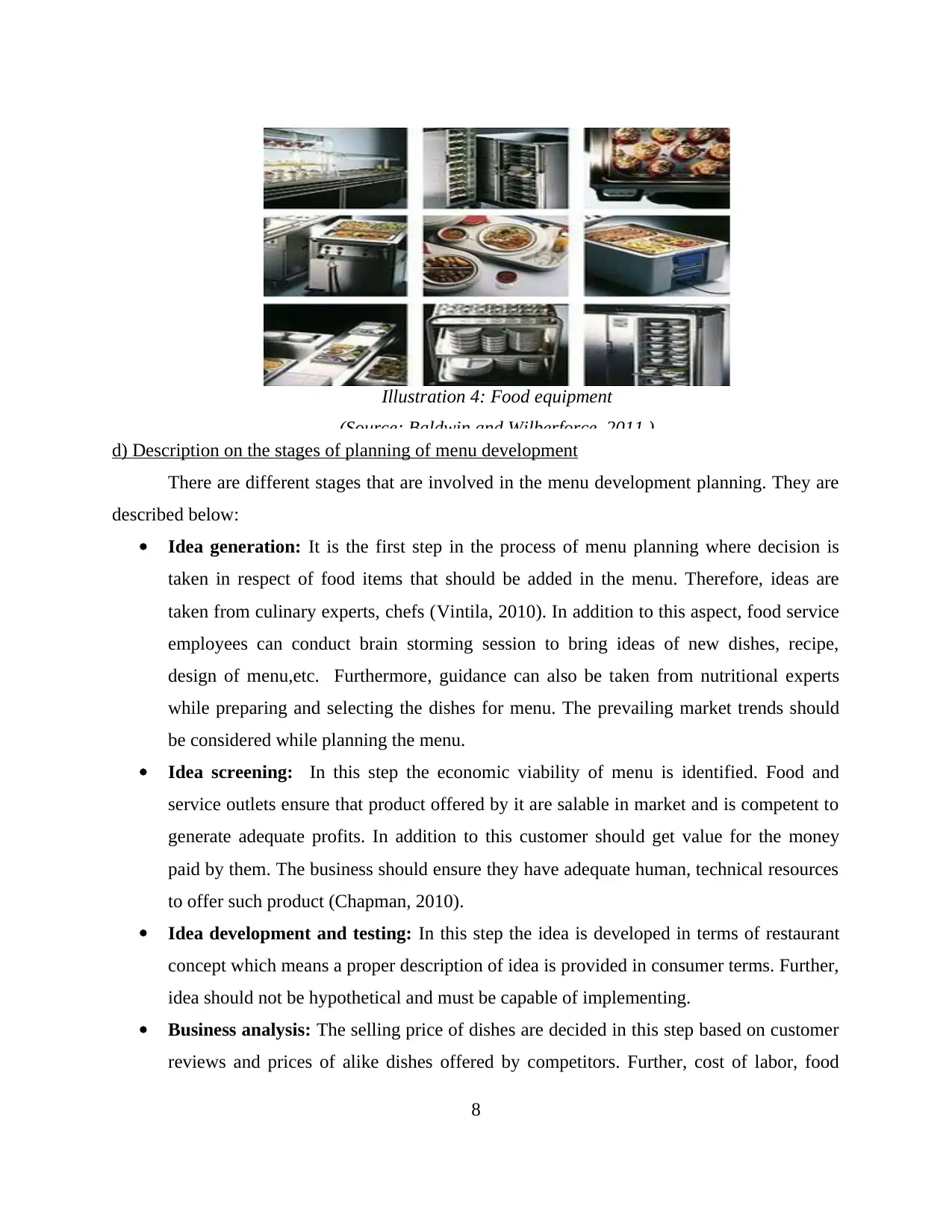
d) Description on the stages of planning of menu development
There are different stages that are involved in the menu development planning. They are
described below:
Idea generation: It is the first step in the process of menu planning where decision is
taken in respect of food items that should be added in the menu. Therefore, ideas are
taken from culinary experts, chefs (Vintila, 2010). In addition to this aspect, food service
employees can conduct brain storming session to bring ideas of new dishes, recipe,
design of menu,etc. Furthermore, guidance can also be taken from nutritional experts
while preparing and selecting the dishes for menu. The prevailing market trends should
be considered while planning the menu.
Idea screening: In this step the economic viability of menu is identified. Food and
service outlets ensure that product offered by it are salable in market and is competent to
generate adequate profits. In addition to this customer should get value for the money
paid by them. The business should ensure they have adequate human, technical resources
to offer such product (Chapman, 2010).
Idea development and testing: In this step the idea is developed in terms of restaurant
concept which means a proper description of idea is provided in consumer terms. Further,
idea should not be hypothetical and must be capable of implementing.
Business analysis: The selling price of dishes are decided in this step based on customer
reviews and prices of alike dishes offered by competitors. Further, cost of labor, food
8
Illustration 4: Food equipment
(Source: Baldwin and Wilberforce, 2011 )
There are different stages that are involved in the menu development planning. They are
described below:
Idea generation: It is the first step in the process of menu planning where decision is
taken in respect of food items that should be added in the menu. Therefore, ideas are
taken from culinary experts, chefs (Vintila, 2010). In addition to this aspect, food service
employees can conduct brain storming session to bring ideas of new dishes, recipe,
design of menu,etc. Furthermore, guidance can also be taken from nutritional experts
while preparing and selecting the dishes for menu. The prevailing market trends should
be considered while planning the menu.
Idea screening: In this step the economic viability of menu is identified. Food and
service outlets ensure that product offered by it are salable in market and is competent to
generate adequate profits. In addition to this customer should get value for the money
paid by them. The business should ensure they have adequate human, technical resources
to offer such product (Chapman, 2010).
Idea development and testing: In this step the idea is developed in terms of restaurant
concept which means a proper description of idea is provided in consumer terms. Further,
idea should not be hypothetical and must be capable of implementing.
Business analysis: The selling price of dishes are decided in this step based on customer
reviews and prices of alike dishes offered by competitors. Further, cost of labor, food
8
Illustration 4: Food equipment
(Source: Baldwin and Wilberforce, 2011 )
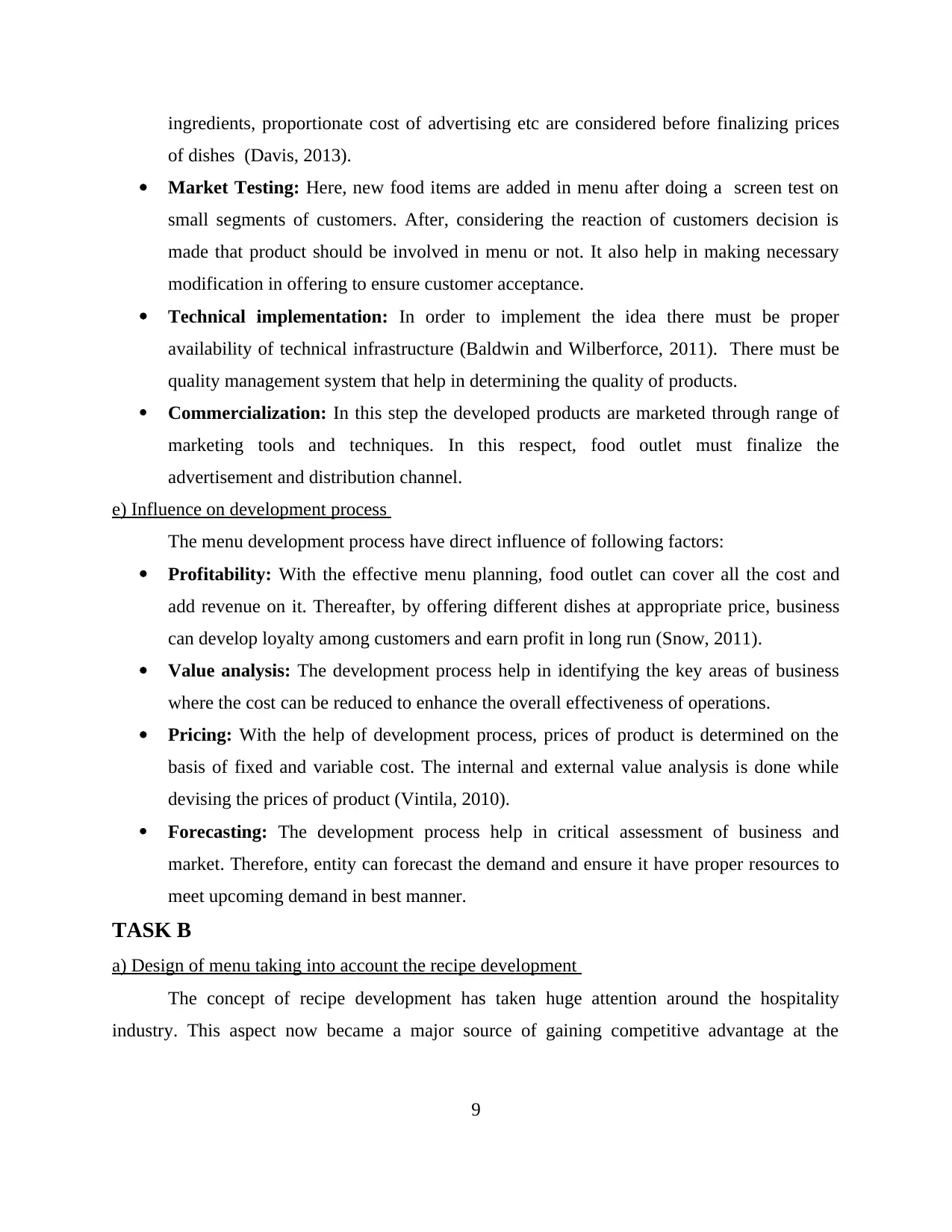
ingredients, proportionate cost of advertising etc are considered before finalizing prices
of dishes (Davis, 2013).
Market Testing: Here, new food items are added in menu after doing a screen test on
small segments of customers. After, considering the reaction of customers decision is
made that product should be involved in menu or not. It also help in making necessary
modification in offering to ensure customer acceptance.
Technical implementation: In order to implement the idea there must be proper
availability of technical infrastructure (Baldwin and Wilberforce, 2011). There must be
quality management system that help in determining the quality of products.
Commercialization: In this step the developed products are marketed through range of
marketing tools and techniques. In this respect, food outlet must finalize the
advertisement and distribution channel.
e) Influence on development process
The menu development process have direct influence of following factors:
Profitability: With the effective menu planning, food outlet can cover all the cost and
add revenue on it. Thereafter, by offering different dishes at appropriate price, business
can develop loyalty among customers and earn profit in long run (Snow, 2011).
Value analysis: The development process help in identifying the key areas of business
where the cost can be reduced to enhance the overall effectiveness of operations.
Pricing: With the help of development process, prices of product is determined on the
basis of fixed and variable cost. The internal and external value analysis is done while
devising the prices of product (Vintila, 2010).
Forecasting: The development process help in critical assessment of business and
market. Therefore, entity can forecast the demand and ensure it have proper resources to
meet upcoming demand in best manner.
TASK B
a) Design of menu taking into account the recipe development
The concept of recipe development has taken huge attention around the hospitality
industry. This aspect now became a major source of gaining competitive advantage at the
9
of dishes (Davis, 2013).
Market Testing: Here, new food items are added in menu after doing a screen test on
small segments of customers. After, considering the reaction of customers decision is
made that product should be involved in menu or not. It also help in making necessary
modification in offering to ensure customer acceptance.
Technical implementation: In order to implement the idea there must be proper
availability of technical infrastructure (Baldwin and Wilberforce, 2011). There must be
quality management system that help in determining the quality of products.
Commercialization: In this step the developed products are marketed through range of
marketing tools and techniques. In this respect, food outlet must finalize the
advertisement and distribution channel.
e) Influence on development process
The menu development process have direct influence of following factors:
Profitability: With the effective menu planning, food outlet can cover all the cost and
add revenue on it. Thereafter, by offering different dishes at appropriate price, business
can develop loyalty among customers and earn profit in long run (Snow, 2011).
Value analysis: The development process help in identifying the key areas of business
where the cost can be reduced to enhance the overall effectiveness of operations.
Pricing: With the help of development process, prices of product is determined on the
basis of fixed and variable cost. The internal and external value analysis is done while
devising the prices of product (Vintila, 2010).
Forecasting: The development process help in critical assessment of business and
market. Therefore, entity can forecast the demand and ensure it have proper resources to
meet upcoming demand in best manner.
TASK B
a) Design of menu taking into account the recipe development
The concept of recipe development has taken huge attention around the hospitality
industry. This aspect now became a major source of gaining competitive advantage at the
9
⊘ This is a preview!⊘
Do you want full access?
Subscribe today to unlock all pages.

Trusted by 1+ million students worldwide
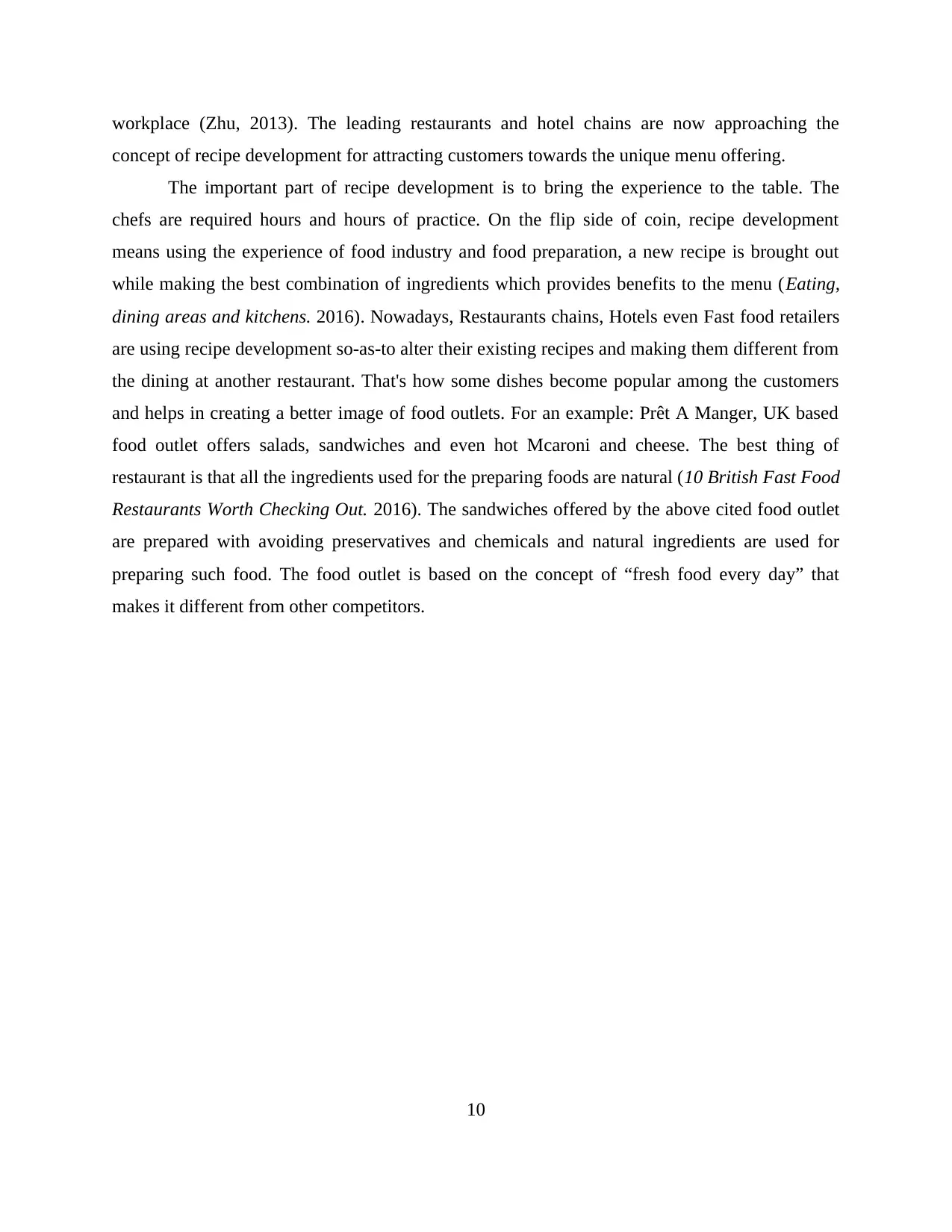
workplace (Zhu, 2013). The leading restaurants and hotel chains are now approaching the
concept of recipe development for attracting customers towards the unique menu offering.
The important part of recipe development is to bring the experience to the table. The
chefs are required hours and hours of practice. On the flip side of coin, recipe development
means using the experience of food industry and food preparation, a new recipe is brought out
while making the best combination of ingredients which provides benefits to the menu (Eating,
dining areas and kitchens. 2016). Nowadays, Restaurants chains, Hotels even Fast food retailers
are using recipe development so-as-to alter their existing recipes and making them different from
the dining at another restaurant. That's how some dishes become popular among the customers
and helps in creating a better image of food outlets. For an example: Prêt A Manger, UK based
food outlet offers salads, sandwiches and even hot Mcaroni and cheese. The best thing of
restaurant is that all the ingredients used for the preparing foods are natural (10 British Fast Food
Restaurants Worth Checking Out. 2016). The sandwiches offered by the above cited food outlet
are prepared with avoiding preservatives and chemicals and natural ingredients are used for
preparing such food. The food outlet is based on the concept of “fresh food every day” that
makes it different from other competitors.
10
concept of recipe development for attracting customers towards the unique menu offering.
The important part of recipe development is to bring the experience to the table. The
chefs are required hours and hours of practice. On the flip side of coin, recipe development
means using the experience of food industry and food preparation, a new recipe is brought out
while making the best combination of ingredients which provides benefits to the menu (Eating,
dining areas and kitchens. 2016). Nowadays, Restaurants chains, Hotels even Fast food retailers
are using recipe development so-as-to alter their existing recipes and making them different from
the dining at another restaurant. That's how some dishes become popular among the customers
and helps in creating a better image of food outlets. For an example: Prêt A Manger, UK based
food outlet offers salads, sandwiches and even hot Mcaroni and cheese. The best thing of
restaurant is that all the ingredients used for the preparing foods are natural (10 British Fast Food
Restaurants Worth Checking Out. 2016). The sandwiches offered by the above cited food outlet
are prepared with avoiding preservatives and chemicals and natural ingredients are used for
preparing such food. The food outlet is based on the concept of “fresh food every day” that
makes it different from other competitors.
10
Paraphrase This Document
Need a fresh take? Get an instant paraphrase of this document with our AI Paraphraser
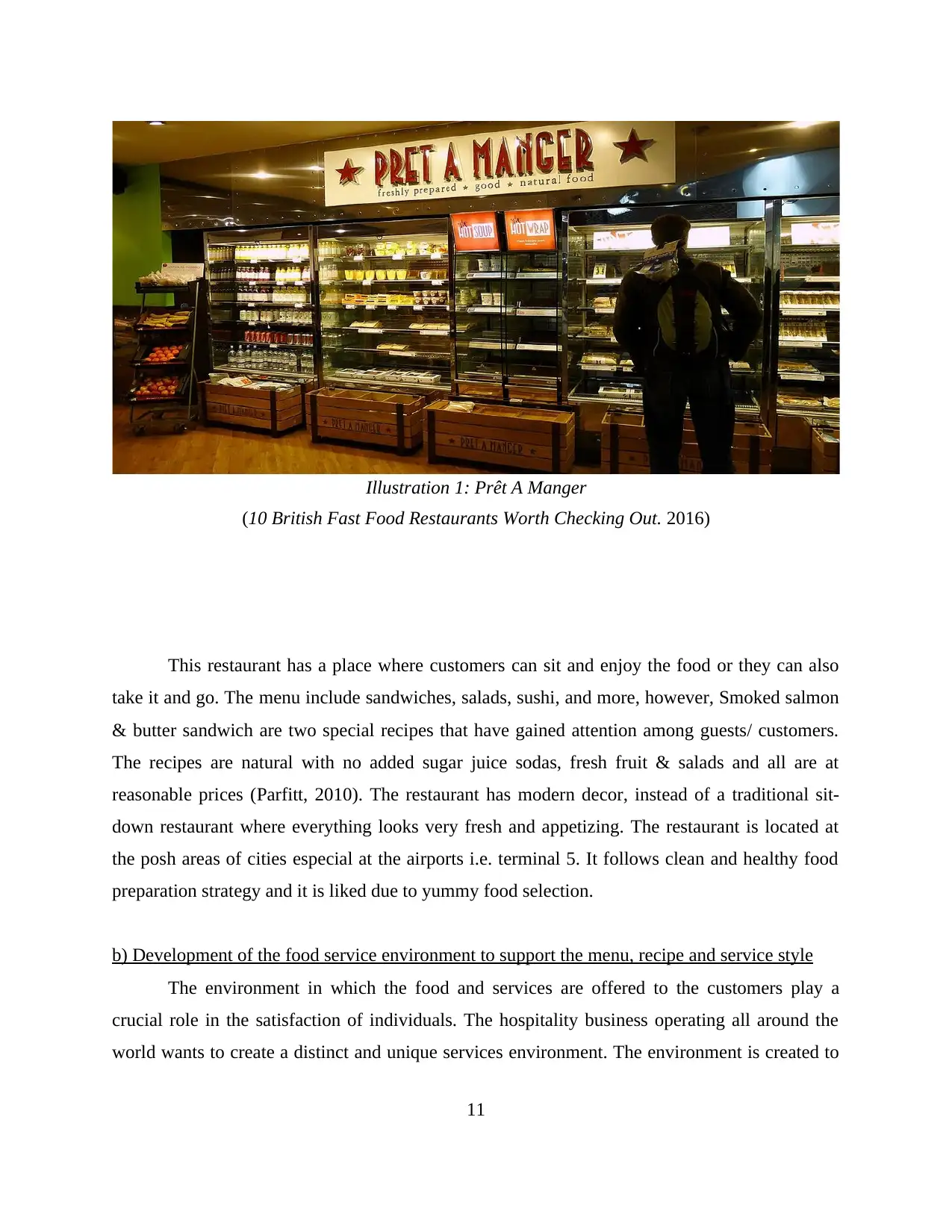
This restaurant has a place where customers can sit and enjoy the food or they can also
take it and go. The menu include sandwiches, salads, sushi, and more, however, Smoked salmon
& butter sandwich are two special recipes that have gained attention among guests/ customers.
The recipes are natural with no added sugar juice sodas, fresh fruit & salads and all are at
reasonable prices (Parfitt, 2010). The restaurant has modern decor, instead of a traditional sit-
down restaurant where everything looks very fresh and appetizing. The restaurant is located at
the posh areas of cities especial at the airports i.e. terminal 5. It follows clean and healthy food
preparation strategy and it is liked due to yummy food selection.
b) Development of the food service environment to support the menu, recipe and service style
The environment in which the food and services are offered to the customers play a
crucial role in the satisfaction of individuals. The hospitality business operating all around the
world wants to create a distinct and unique services environment. The environment is created to
11
Illustration 1: Prêt A Manger
(10 British Fast Food Restaurants Worth Checking Out. 2016)
take it and go. The menu include sandwiches, salads, sushi, and more, however, Smoked salmon
& butter sandwich are two special recipes that have gained attention among guests/ customers.
The recipes are natural with no added sugar juice sodas, fresh fruit & salads and all are at
reasonable prices (Parfitt, 2010). The restaurant has modern decor, instead of a traditional sit-
down restaurant where everything looks very fresh and appetizing. The restaurant is located at
the posh areas of cities especial at the airports i.e. terminal 5. It follows clean and healthy food
preparation strategy and it is liked due to yummy food selection.
b) Development of the food service environment to support the menu, recipe and service style
The environment in which the food and services are offered to the customers play a
crucial role in the satisfaction of individuals. The hospitality business operating all around the
world wants to create a distinct and unique services environment. The environment is created to
11
Illustration 1: Prêt A Manger
(10 British Fast Food Restaurants Worth Checking Out. 2016)
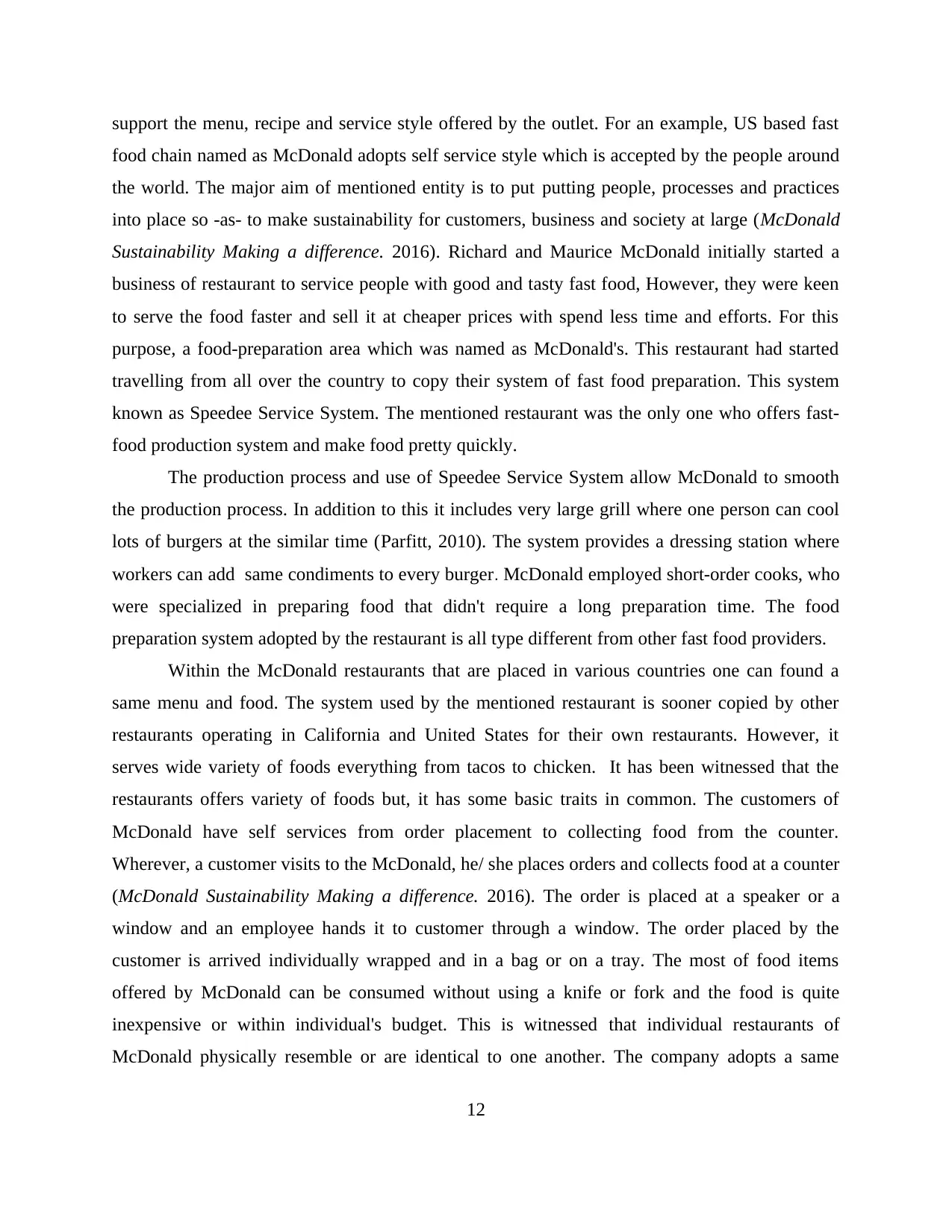
support the menu, recipe and service style offered by the outlet. For an example, US based fast
food chain named as McDonald adopts self service style which is accepted by the people around
the world. The major aim of mentioned entity is to put putting people, processes and practices
into place so -as- to make sustainability for customers, business and society at large (McDonald
Sustainability Making a difference. 2016). Richard and Maurice McDonald initially started a
business of restaurant to service people with good and tasty fast food, However, they were keen
to serve the food faster and sell it at cheaper prices with spend less time and efforts. For this
purpose, a food-preparation area which was named as McDonald's. This restaurant had started
travelling from all over the country to copy their system of fast food preparation. This system
known as Speedee Service System. The mentioned restaurant was the only one who offers fast-
food production system and make food pretty quickly.
The production process and use of Speedee Service System allow McDonald to smooth
the production process. In addition to this it includes very large grill where one person can cool
lots of burgers at the similar time (Parfitt, 2010). The system provides a dressing station where
workers can add same condiments to every burger. McDonald employed short-order cooks, who
were specialized in preparing food that didn't require a long preparation time. The food
preparation system adopted by the restaurant is all type different from other fast food providers.
Within the McDonald restaurants that are placed in various countries one can found a
same menu and food. The system used by the mentioned restaurant is sooner copied by other
restaurants operating in California and United States for their own restaurants. However, it
serves wide variety of foods everything from tacos to chicken. It has been witnessed that the
restaurants offers variety of foods but, it has some basic traits in common. The customers of
McDonald have self services from order placement to collecting food from the counter.
Wherever, a customer visits to the McDonald, he/ she places orders and collects food at a counter
(McDonald Sustainability Making a difference. 2016). The order is placed at a speaker or a
window and an employee hands it to customer through a window. The order placed by the
customer is arrived individually wrapped and in a bag or on a tray. The most of food items
offered by McDonald can be consumed without using a knife or fork and the food is quite
inexpensive or within individual's budget. This is witnessed that individual restaurants of
McDonald physically resemble or are identical to one another. The company adopts a same
12
food chain named as McDonald adopts self service style which is accepted by the people around
the world. The major aim of mentioned entity is to put putting people, processes and practices
into place so -as- to make sustainability for customers, business and society at large (McDonald
Sustainability Making a difference. 2016). Richard and Maurice McDonald initially started a
business of restaurant to service people with good and tasty fast food, However, they were keen
to serve the food faster and sell it at cheaper prices with spend less time and efforts. For this
purpose, a food-preparation area which was named as McDonald's. This restaurant had started
travelling from all over the country to copy their system of fast food preparation. This system
known as Speedee Service System. The mentioned restaurant was the only one who offers fast-
food production system and make food pretty quickly.
The production process and use of Speedee Service System allow McDonald to smooth
the production process. In addition to this it includes very large grill where one person can cool
lots of burgers at the similar time (Parfitt, 2010). The system provides a dressing station where
workers can add same condiments to every burger. McDonald employed short-order cooks, who
were specialized in preparing food that didn't require a long preparation time. The food
preparation system adopted by the restaurant is all type different from other fast food providers.
Within the McDonald restaurants that are placed in various countries one can found a
same menu and food. The system used by the mentioned restaurant is sooner copied by other
restaurants operating in California and United States for their own restaurants. However, it
serves wide variety of foods everything from tacos to chicken. It has been witnessed that the
restaurants offers variety of foods but, it has some basic traits in common. The customers of
McDonald have self services from order placement to collecting food from the counter.
Wherever, a customer visits to the McDonald, he/ she places orders and collects food at a counter
(McDonald Sustainability Making a difference. 2016). The order is placed at a speaker or a
window and an employee hands it to customer through a window. The order placed by the
customer is arrived individually wrapped and in a bag or on a tray. The most of food items
offered by McDonald can be consumed without using a knife or fork and the food is quite
inexpensive or within individual's budget. This is witnessed that individual restaurants of
McDonald physically resemble or are identical to one another. The company adopts a same
12
⊘ This is a preview!⊘
Do you want full access?
Subscribe today to unlock all pages.

Trusted by 1+ million students worldwide
1 out of 17
Related Documents
Your All-in-One AI-Powered Toolkit for Academic Success.
+13062052269
info@desklib.com
Available 24*7 on WhatsApp / Email
![[object Object]](/_next/static/media/star-bottom.7253800d.svg)
Unlock your academic potential
Copyright © 2020–2025 A2Z Services. All Rights Reserved. Developed and managed by ZUCOL.





